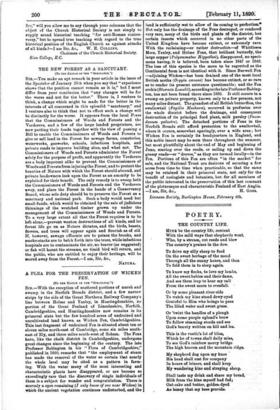A PLEA FOR THE PRESERVATION OF WICKEN
FEN.
[TO THE EDITOR OF THE "SPECTATOR.1
SIR.—With the exception of scattered portions of marsh and swamp in the Norfolk Broads district, and a few narrow strips by the side of the Great Northern Railway Company's line between Holme and Yaxley, in Huntingdonshire, no portion of the Great Fenland of Lincolnshire, Norfolk, Cambridgeshire, and Huntingdonshire now remains in its primeval state but the few hundred acres of undrained and uncultivated land known as Wicken Fen, Cambridgeshire. This last fragment of undrained Fen is situated about ten or eleven miles north-east of Cambridge, some six miles south- east of Ely, and three miles south-west of Soham. The Fens have, like the chalk district in Cambridgeshire, undergone great changes since the beginning of the century. The late Professor Babington in his " Flora of Cambridgeshire," published in 1860, remarks that "the employment of steam has made the removal of the water so certain that nearly the whole level may be cited as a pattern in farm- ing. With the water many of the most interesting and characteristic plants have disappeared, or are become so exceedingly rare that the discovery of single individuals of them is a subject for wonder and congratulation. There is scarcely a spot remaining (I only know of one near Wicken) in which the ancient vegetation continues undisturbed, and the land is sufficiently wet to allow of its coming to perfection." Not only has the drainage of the Fens destroyed, or rendered very rare, many of the birds and plants of the district, but certain insects which occurred in no other parts of the United Kingdom have become extinct, or extremely rare; With the reclaiming—or rather destruction—of Whittlesea Mere, Yaxley, and Holme Fens, that brilliant butterfly, the large copper (Polycnnmatus Hippothoe), disappeared, no speci. mans having, it is believed, been taken since 1847 or 1843. The loss of this species is the more to be regretted as the Continental form is not identical with it. Since Burwell Fen —adjoining Wicken—has been drained one of the most local British moths (Orgyia ccenosa) has become extinct, or so rare as to render its present existence questionable; and the Fen orchis (Sturnvia Loeselii), according to the late Professor Ba.bing. ton, has not been found there since 1836. It still occurs in a swamp on private property, known only to a few persons, not many miles distant. The grandest of all British butterflies, the swallowtail (Papilio Machaon), occurred in profusion over the whole district before the drainage, and consequent destruction of its principal food plant, milk parsley (Fence- danunt. palustre). The detached portions of Fens in the Norfolk Broads still afford protection to the swallowtail, where it occurs, somewhat sparingly, over a wide area ; but Wicken Fen is certainly its headquarters in England, and this noble insect may be seen there throughout the summer, but moat plentifully about the end of May and beginning of Jane, soaring over the reeds, or sailing up and down the grassy roads—or "droves," as they are termed locally—in the Fen. Portions of this Fen are often "in the market" for sale, and the National Trust are desirous of securing a few acres from time to time when practicable, so that the same may be retained in their primeval state, not only for the benefit of zoologists and botanists, but for all members of the public interested in the preservation of this last remnant of the picturesque and characteristic Fenland of East Anglia.
Linnean Society, Burlington House, February 8th.






































 Previous page
Previous page